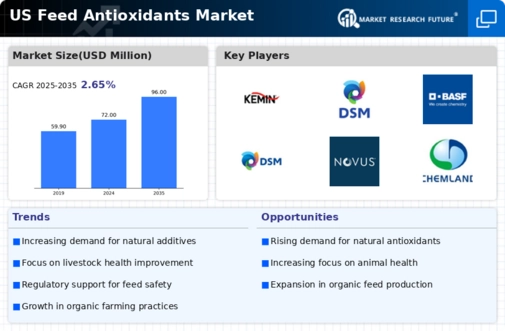The feed antioxidants market is currently characterized by a dynamic competitive landscape, driven by increasing demand for high-quality animal feed and a growing awareness of the benefits of antioxidants in enhancing animal health and productivity. Key players such as BASF SE (DE), Cargill Inc (US), and Kemin Industries Inc (US) are strategically positioned to leverage innovation and sustainability in their operations. BASF SE (DE) focuses on developing advanced antioxidant solutions that cater to the evolving needs of the livestock sector, while Cargill Inc (US) emphasizes partnerships and collaborations to enhance its product offerings. Kemin Industries Inc (US) is also notable for its commitment to research and development, which underpins its competitive edge in the market. Collectively, these strategies contribute to a robust competitive environment, fostering innovation and responsiveness to market demands.
In terms of business tactics, companies are increasingly localizing manufacturing and optimizing supply chains to enhance efficiency and reduce costs. The market structure appears moderately fragmented, with several key players exerting influence over specific segments. This fragmentation allows for niche players to thrive, while larger corporations capitalize on economies of scale and extensive distribution networks. The collective influence of these key players shapes market dynamics, as they compete not only on product quality but also on service delivery and customer engagement.
In October 2025, Kemin Industries Inc (US) announced the launch of a new line of natural feed antioxidants aimed at improving the shelf life and nutritional value of animal feed. This strategic move underscores Kemin's commitment to sustainability and innovation, as it seeks to address the growing consumer demand for natural and organic products. By enhancing its product portfolio, Kemin positions itself to capture a larger market share and respond effectively to evolving consumer preferences.
In September 2025, Cargill Inc (US) expanded its partnership with a leading agricultural technology firm to integrate AI-driven analytics into its feed production processes. This initiative is likely to enhance operational efficiency and product quality, allowing Cargill to better meet the specific needs of its customers. The integration of advanced technologies reflects a broader trend within the industry towards digital transformation, which is becoming increasingly critical for maintaining competitive advantage.
In August 2025, BASF SE (DE) entered into a strategic alliance with a prominent livestock nutrition company to co-develop innovative feed solutions. This collaboration aims to leverage both companies' expertise in nutrition and antioxidants, potentially leading to groundbreaking advancements in feed formulations. Such strategic alliances are indicative of a trend towards collaborative innovation, which is essential for addressing the complex challenges faced by the feed industry today.
As of November 2025, Competitive trends in the feed antioxidants market are defined by digitalization, sustainability, and AI technology integration. Strategic alliances are playing a pivotal role in shaping the landscape, enabling companies to pool resources and expertise to drive innovation. Looking ahead, it appears that competitive differentiation will increasingly hinge on factors such as technological advancement, product innovation, and supply chain reliability, rather than solely on price. This shift suggests a more sophisticated competitive environment, where companies that prioritize innovation and sustainability are likely to emerge as leaders.




















Leave a Comment